Chapter 6 – Menu Engineering and Design
Pauline Milwood
It is fair to say that the menu is the single most important document in the business. Purchasing, production, sales, cost accounting, labor management, even the kitchen layout and equipment selection of a new facility—all are based on the menu.
—Lea R. Dopson and David K. Hayes, Food and Beverage Cost Control
Learning Objectives
At the end of this chapter, students will be able to:
- Understand the principal types of menus for pop-up dining
- Understand what is meant by the term menu engineering
- Understand and apply the principles of ethics, responsibility, and sustainability to menu design
- Develop high-quality menu ideas for a five-course pop-up dinner experience
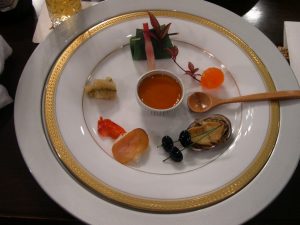
Image credit: “First course of a tasting menu at ‘Iron Chef’ Rokusaburo Michiba’s restaurant ‘Rokusan tei’ in Ginza, Tokyo” by Schellack via Wikimedia Commons in the public domain.
Chapter Warm-Up
Prechapter Reading Materials
- “Basic Kitchen and Food Service Management” (BC Cook Articulation Committee 2015)
- “Menu Analysis (Engineering)” (Egan n.d.)
- “How to Make Your Menu a Money-Maker Using Restaurant Menu Design” (Duyne n.d.)
- Food and Beverage Cost Control (Dopson and Hayes 2019, 198–215)
- Professional Cooking (Gisslen 2018, 64–75)
Prechapter Exercise
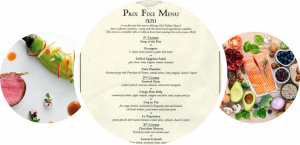
CHAPTER OUTLINE
- Menu Forms and Function
- Menu Types
- Menu Engineering
- Key Consideration for Pop-Up Menus
Menu forms and function
Menu planning must be undertaken with one fundamental principle: menus are planned for the people eating the food. It is easy for popupreneurs to fall into the trap of planning and designing menus attractive to them without remembering that the pop-up diner is the focal point of determining menu success or failure. Following food trends related to cultural preferences, tastes, healthy eating, and wellness helps popupreneurs plan and implement menu ideas successfully.
Other factors, such as seasonality, locality, restaurant theme/concept, and duration, are important considerations in pop-up menu planning. For example, countries that experience heavy seasonal fluctuations must limit their menu item consideration to seasonally available ingredients. A fall-themed pop-up restaurant will utilize significantly different menu items and ingredients, such as smoked tomatoes or preserved fruit, than, say, a summer-themed pop-up restaurant, which may have readily available vine-ripened tomatoes and fresh fruits and vegetables.
Support for local ingredients and industry has also increased. Diners today have a preference for food grown, reared, and produced locally. Not only does food served closer to the point of its original source taste better, but it provides the added benefit of supporting the local community. These types of menu-planning considerations support sustainability in the local food supply chain and provide the added benefit of better-tasting food. This trend has been around for some time and is commonly referred to as farm-to-table or farm-to-fork.
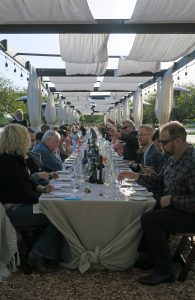
Most menus are based on the classical menu format, which features a series of hot/cold appetizers, hot/cold soups, hot/cold entrées, and hot/cold desserts, with the option to have palette cleansers (e.g., sorbet) in between courses. Below is an example of a classical twelve-course menu (though menus can go up to fifteen courses or more!):
- Cold hors d’oeuvres
- Soup
- Hot hors d’oeuvres
- Fish
- Main course
- Hot entrée
- Cold entrée
- Sorbet
- Roast
- Vegetable
- Sweet
- Dessert.
Menus function as a signaling mechanism to prospective diners. Menus can communicate aspects of the pop-up restaurant, such as its locality, theme, seasonality, formality, and extent of luxury. While other aspects of the pop-up restaurant are key to shaping guests’ appeal, it is generally the menu that most guests turn their attention to when deciding whether to eat in a particular restaurant or not. Popupreneurs must therefore give careful consideration to their target audience (see chapters 4 and 5) when designing menus. For example, millennials have preferences to experience new cultures and diversity when dining out. They are also interested in sustainably grown, ethically sourced, and environmentally friendly food practices, and they support establishments that promote these values and activities. Seniors and retirees, on the other hand, may have higher disposable income and may be open to a pop-up dining experience that includes a bottle of high-quality wine paired with novel menu items.
Menu types
Several variations of the classical menu are in use in restaurants today, with more modern twists being placed on most. These are discussed below.
À la carte menu. When managers use an à la carte menu, guests select individual menu items. Each menu item is priced separately. With the à la carte menu, guests choose individual items they want and are charged only for the items they select. Characteristics include itemized choice and itemized price. Here is an example: https://parc-restaurant.com/.
Several variations of the classical menu are in use in restaurants today, with more modern twists being placed on most. These are discussed below.
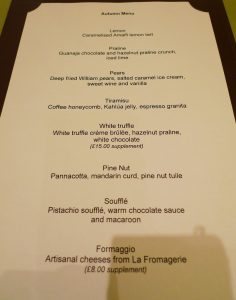
Image credit: “Murano, Mayfair, W1” by Ewan Munro via flickr under CC BY-SA 2.0.
prix fixe menu. The prix fixe (pronounced “prefix”) menu is the most common style of menu. With the prix fixe menu, guests choose from a predetermined list of items presented as a multicourse meal. The items included in the meal are then sold at one set price. This is among the most popular pop-up menu formats. Here is an example: https://amorette.com.
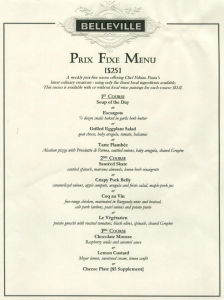
Image credit: “Best Photos Of Fixed Menu For Restaurant Prix Fixe Menu in Prix Fixe Menu Template” by Jeniffer via VanceCountyFair.com under VanceCountyFair.com Terms of Use.
table d′ hôte menu. The table d′hôte menu format contains fixed menu items served plated or buffet style. It is often the case that this menu form offers diners the option to select from a list of items within each course for a predetermined price. The table d′hôte menu format is frequently used in banquet-style events, where some degree of menu flexibility or guest choice is desired. This menu format, however, does require the hospitality manager and their production and service teams to carefully balance accommodating diner variations and monitoring menu-item profit margins.
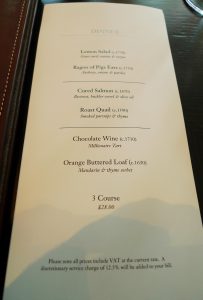
Image credit: “The set lunch menu. At Dinner by Heston Blumenthal, Knightsbridge” by Ewan Munro via Wikimedia Commons under CC BY-SA 2.0.
tasting menu. An increasingly popular menu type, the tasting menu derives its name from the French term degústation, referring to a collection of small portions served as a single meal. Tasting menus usually comprise eight or more courses. Portion size and cost become secondary factors, as the goal is usually to showcase the culinary talents of a chef. Tasting menus have been extended to beverage tasting rooms, featuring wines, beers, and spirits. Here is an example: https://amorette.com.
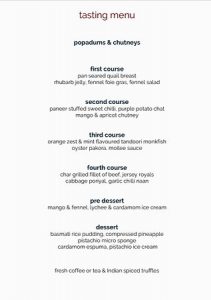
Image credit: “Menü” by bribro2013 via TripAdvisor.com under Trip Advisor Terms of Use.
Menu Engineering
Menu engineering uses psychology, food cost, and design principles to improve diner satisfaction and profitability (WebstaurantStore.com). It is a way to evaluate a restaurant’s menu pricing by using sales data and food costs to guide which dishes to feature and their menu price in such a manner as to maximize revenue. Menu engineering seeks to understand the profitability of menu items so that high-profit items can be positioned for higher demand among guests and low-profit items can be positioned for lower demand among guests. This allows the popupreneur to maximize menu-item profits based on the strategic positioning of high-popularity and high-profitability items within the so-called golden triangle of the menu page. The golden triangle describes how diners’ eyes roam, or view, areas of a restaurant menu—typically beginning in the center of the page, moving to the top right, and then to the top left. Studies suggest that listing key menu items at the center or top right of the page will maximize the visibility of those items. Other steps include training waitstaff on seasonal specials, using imagery or other highlights, and making modifications to portion sizes to increase the intake of specific ingredients, such as vegetables, starters, or other seasonal menu items (Reinders et al. 2017).
Rankin (2020) identifies five specific steps in the menu-engineering process:
- Identify a time period (breakfast, lunch, dinner).
- Analyze your food cost for each menu item.
- Reorganize/classify menu items based on popularity and profitability.
- Redesign and restructure your menu:
- Choose the ideal menu configuration.
- Write appealing menu descriptions.
- Emphasize high-popularity and high-profitability items.
- Consider eye movements.
- Be aware of the burden of choice.
- Train team members.
- Measure performance.
Key consideration for pop-up menus
Given the unique characteristics of a pop-up restaurant (duration, seasonality, lack of historical data, and general uncertainties surrounding in-person dining), certain key design considerations should be given to menu ideas. The lack of a permanent restaurant facility means the absence of a carry-over facility. Unused food items will need to be discarded, and this could lead to a higher-than-normal food-cost percentage. While the absence of historical data may make accurate guest-count projections difficult, understanding local tastes and meal preferences will help ensure high-quality service due to having an appropriate sales mix. This will also help minimize closing inventory and food waste at the end of the event, which will contribute to a higher food cost.
Other key considerations include the availability of human and technical skills and resources. The expertise (human effort and talent) needed to produce the menu items should also be considered. A Moroccan-themed pop-up restaurant, for instance, will need to ensure that the chef is knowledgeable of specialty Mediterranean/Moorish cuisine, including spices and cooking methods that help create an authentic dining experience. Often, convenience foods such as concentrated bases and bread rolls may be used instead of preparing stocks from scratch. Based on available resources, popupreneurs must perform make-or-buy decision-making to determine whether to outsource or prepare an item in-house for the pop-up.
Most pop-ups will be located within spaces already equipped with basic kitchen equipment. However, it is important that popupreneurs plan for menu items for which adequate preparation and production equipment are available. For example, cooking and cooling equipment will be needed for food preparation, but if there is no accessible fryer, considerations should be given to either avoiding fried foods on the menu or outsourcing a fryer for the pop-up. Consideration should also be given to foods containing allergens and other potentially hazardous foods.
Menu accuracy is another key consideration that relates to the ethical responsibilities of the popupreneur. In addition to ensuring authenticity, menu accuracy ensures that the correct representation of local and global food culture is preserved. It is also the responsibility of the popupreneur to engage in ethical menu pricing to ensure that guests are not being over- (or under)charged for their dining experiences. For example, stating the availability of a Faroe Islands salmon dish on your menu means that salmon must have been sourced from the Faroe Islands and not the Atlantic.
KEY TERMS
- à la carte menu
- classical menu
- farm-to-table or farm-to-fork
- menu engineering
- prix fixe menu
- sales mix
- static menu
- table d′ hôte
- tasting menu
REVIEW Questions
- What are the differences between a menu for a traditional restaurant and one for a pop-up restaurant?
- Oftentimes, dessert menu items will have to be outsourced if there is no in-house pastry/dessert chef. What are some ways to minimize food costs if dessert must be outsourced?
- How can popupreneurs engage in ethical menu planning and design practices?
Review Activities
- In your favorite browser, search for “pop-up restaurant menu examples”. Which types of menu are most popular, if any?
- Watch the video, The Economics of Pop-up Restaurants, and answer the questions.
Pop-up Project Task
- Based on the materials covered in this chapter, and in pre-requisite courses, create a four- to five-course fine dining menu for your pop-up restaurant.
Resources
Chapter References
Amorette. 2022. Accessed January 17, 2022. https://amorette.com/.
BC Cook Articulation Committee. 2015. “Basic Kitchen and Food Service Management.” BCcampus. https://opentextbc.ca/basickitchenandfoodservicemanagement/.
Dopson, Lea R., and David K. Hayes. 2019. Food and Beverage Cost Control. Hoboken, NJ: Wiley.
Duyne, Allie Van. n.d. “How to Make Your Menu a Money-Maker Using Restaurant Menu Design.” On the Line. Accessed January 17, 2022. https://pos.toasttab.com/blog/on-the-line/menu-engineering-menu-design.
Egan, Beth. n.d. “Menu Analysis (Engineering).” In Introduction to Food Production and Service. State College, PA: Affordable Course Transformation: Pennsylvania State University. https://psu.pb.unizin.org/hmd329/chapter/ch9/.
Gisslen, Wayne. 2018. Professional Cooking. Hoboken, NJ: Wiley.
Parc. n.d. Accessed January 17, 2022. https://parc-restaurant.com/.
Rankin, Sebastien. 2020. “Menu Engineering: How to Make a Profitable Restaurant Menu.” Lightspeed, April 8, 2020. https://www.lightspeedhq.com/blog/menu-engineering/.
Reinders, Machiel J., Marlijn Huitink, S. Coosje Dijkstra, Anna J. Maaskant, and Joris Heijnen. 2017. “Menu-Engineering in Restaurants—Adapting Portion Sizes on Plates to Enhance Vegetable Consumption: A Real-Life Experiment.” International Journal of Behavioral Nutrition and Physical Activity 14 (41): 1–11. https://ijbnpa.biomedcentral.com/articles/10.1186/s12966-017-0496-9.
Wall Street Journal. 2012. “The Economics of Pop-Up Restaurants.” Last modified March 22, 2012. YouTube video, 3:26. https://youtu.be/QtPZj9ssKEU.
WebstaurantStore. 2022. “Menu Engineering: How to Create a Profitable Menu.” Last modified August 19, 2019. https://www.webstaurantstore.com/article/89/menu-psychology-the-science-behind-menu-engineering.html.
A form of dining in which guests are situated at or in close proximity to the source of menu ingredients used to produce items on the menu
a menu format in which guests select individual menu items, each of which is priced separately.
a restaurant menu which offers a 'fixed' selection of dishes, often without choice options within each course
a menu that offers a multi-course meal—with multiple options for each course—at a fixed total price
a fixed-price restaurant meal or menu consisting of small portions of numerous dishes
A menu analysis approach that classifies menu items as Stars, Puzzles, Plow Horses, or Dogs.

